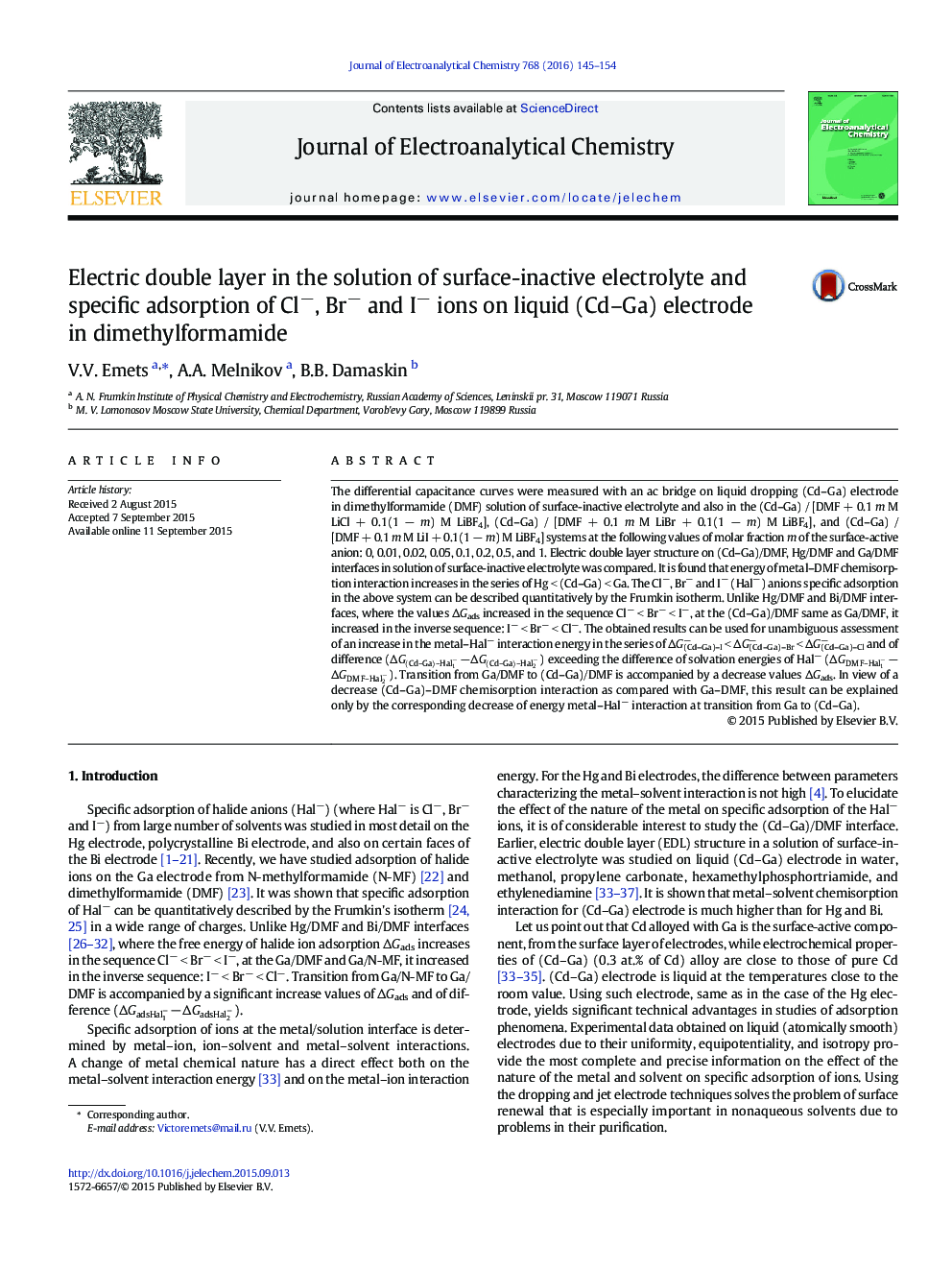| کد مقاله | کد نشریه | سال انتشار | مقاله انگلیسی | نسخه تمام متن |
|---|---|---|---|---|
| 217973 | 463176 | 2016 | 10 صفحه PDF | دانلود رایگان |

• Energy of metal–DMF interaction increases in the series of (Cd–Ga) < Ga.
• The adsorption of Hal− on (Cd–Ga)/DMF can be described by the Frumkin isotherm.
• The adsorption energy ΔGads on (Cd–Ga) unlike Hg grows in the series of I− < Br− < Cl−.
• The difference of metal–Hal− energy ΔGM–Hal1−−ΔGM–Hal2− decreases from Ga to (Cd–Ga).
• The values ΔGads of Hal− decrease at transition from Ga/DMF to (Cd–Ga)/DMF.
The differential capacitance curves were measured with an ac bridge on liquid dropping (Cd–Ga) electrode in dimethylformamide (DMF) solution of surface-inactive electrolyte and also in the (Cd–Ga) / [DMF + 0.1 m M LiCl + 0.1(1 − m) M LiBF4], (Cd–Ga) / [DMF + 0.1 m M LiBr + 0.1(1 − m) M LiBF4], and (Cd–Ga) / [DMF + 0.1 m M LiI + 0.1(1 − m) M LiBF4] systems at the following values of molar fraction m of the surface-active anion: 0, 0.01, 0.02, 0.05, 0.1, 0.2, 0.5, and 1. Electric double layer structure on (Cd–Ga)/DMF, Hg/DMF and Ga/DMF interfaces in solution of surface-inactive electrolyte was compared. It is found that energy of metal–DMF chemisorption interaction increases in the series of Hg < (Cd–Ga) < Ga. The Cl−, Br− and I− (Hal−) anions specific adsorption in the above system can be described quantitatively by the Frumkin isotherm. Unlike Hg/DMF and Bi/DMF interfaces, where the values ΔGads increased in the sequence Cl− < Br− < I−, at the (Cd–Ga)/DMF same as Ga/DMF, it increased in the inverse sequence: I− < Br− < Cl−. The obtained results can be used for unambiguous assessment of an increase in the metal–Hal− interaction energy in the series of ΔG(Cd–Ga)–I− < ΔG(Cd–Ga)–Br− < ΔG(Cd–Ga)–Cl− and of difference (ΔGCd–Ga–Hal1−−ΔGCd–Ga–Hal2−) exceeding the difference of solvation energies of Hal− (ΔGDMF–Hal1−−ΔGDMF–Hal2−). Transition from Ga/DMF to (Cd–Ga)/DMF is accompanied by a decrease values ΔGads. In view of a decrease (Cd–Ga)–DMF chemisorption interaction as compared with Ga–DMF, this result can be explained only by the corresponding decrease of energy metal–Hal− interaction at transition from Ga to (Cd–Ga).
Figure optionsDownload as PowerPoint slide
Journal: Journal of Electroanalytical Chemistry - Volume 768, 1 May 2016, Pages 145–154